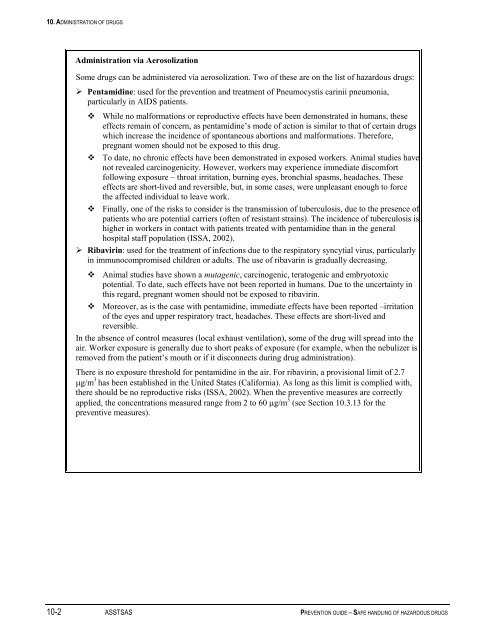Prevention Guide - Safe Handling of Hazardous Drugs - Irsst
Prevention Guide - Safe Handling of Hazardous Drugs - Irsst
Prevention Guide - Safe Handling of Hazardous Drugs - Irsst
You also want an ePaper? Increase the reach of your titles
YUMPU automatically turns print PDFs into web optimized ePapers that Google loves.
10. ADMINISTRATION OF DRUGS<br />
Administration via Aerosolization<br />
Some drugs can be administered via aerosolization. Two <strong>of</strong> these are on the list <strong>of</strong> hazardous drugs:<br />
‣ Pentamidine: used for the prevention and treatment <strong>of</strong> Pneumocystis carinii pneumonia,<br />
particularly in AIDS patients.<br />
While no malformations or reproductive effects have been demonstrated in humans, these<br />
effects remain <strong>of</strong> concern, as pentamidine’s mode <strong>of</strong> action is similar to that <strong>of</strong> certain drugs<br />
which increase the incidence <strong>of</strong> spontaneous abortions and malformations. Therefore,<br />
pregnant women should not be exposed to this drug.<br />
To date, no chronic effects have been demonstrated in exposed workers. Animal studies have<br />
not revealed carcinogenicity. However, workers may experience immediate discomfort<br />
following exposure – throat irritation, burning eyes, bronchial spasms, headaches. These<br />
effects are short-lived and reversible, but, in some cases, were unpleasant enough to force<br />
the affected individual to leave work.<br />
Finally, one <strong>of</strong> the risks to consider is the transmission <strong>of</strong> tuberculosis, due to the presence <strong>of</strong><br />
patients who are potential carriers (<strong>of</strong>ten <strong>of</strong> resistant strains). The incidence <strong>of</strong> tuberculosis is<br />
higher in workers in contact with patients treated with pentamidine than in the general<br />
hospital staff population (ISSA, 2002).<br />
‣ Ribavirin: used for the treatment <strong>of</strong> infections due to the respiratory syncytial virus, particularly<br />
in immunocompromised children or adults. The use <strong>of</strong> ribavarin is gradually decreasing.<br />
Animal studies have shown a mutagenic, carcinogenic, teratogenic and embryotoxic<br />
potential. To date, such effects have not been reported in humans. Due to the uncertainty in<br />
this regard, pregnant women should not be exposed to ribavirin.<br />
Moreover, as is the case with pentamidine, immediate effects have been reported –irritation<br />
<strong>of</strong> the eyes and upper respiratory tract, headaches. These effects are short-lived and<br />
reversible.<br />
In the absence <strong>of</strong> control measures (local exhaust ventilation), some <strong>of</strong> the drug will spread into the<br />
air. Worker exposure is generally due to short peaks <strong>of</strong> exposure (for example, when the nebulizer is<br />
removed from the patient’s mouth or if it disconnects during drug administration).<br />
There is no exposure threshold for pentamidine in the air. For ribavirin, a provisional limit <strong>of</strong> 2.7<br />
g/m 3 has been established in the United States (California). As long as this limit is complied with,<br />
there should be no reproductive risks (ISSA, 2002). When the preventive measures are correctly<br />
applied, the concentrations measured range from 2 to 60 g/m 3 (see Section 10.3.13 for the<br />
preventive measures).<br />
10-2 ASSTSAS PREVENTION GUIDE – SAFE HANDLING OF HAZARDOUS DRUGS

















